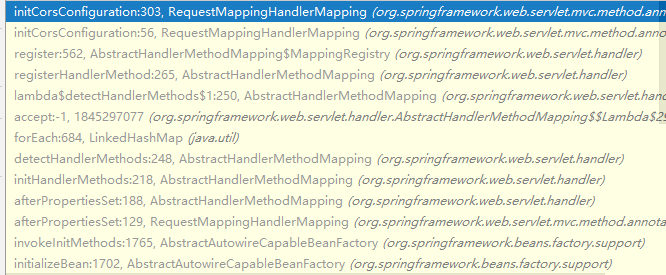小编给大家分享一下Spring @CrossOrigin注解原理是什么,希望大家阅读完这篇文章后大所收获,下面让我们一起去探讨吧!
先说原理:其实很简单,就是利用spring的拦截器实现往response里添加 Access-Control-Allow-Origin等响应头信息,我们可以看下spring是怎么做的
注:这里使用的spring版本为5.0.6
我们可以先往RequestMappingHandlerMapping 的initCorsConfiguration方法打一个断点,发现方法调用情况如下

如果controller在类上标了@CrossOrigin或在方法上标了@CrossOrigin注解,则spring 在记录mapper映射时会记录对应跨域请求映射,代码如下
RequestMappingHandlerMapping
protected CorsConfiguration initCorsConfiguration(Object handler, Method method, RequestMappingInfo mappingInfo) {
HandlerMethod handlerMethod = createHandlerMethod(handler, method);
Class<?> beanType = handlerMethod.getBeanType();
//获取handler上的CrossOrigin 注解
CrossOrigin typeAnnotation = AnnotatedElementUtils.findMergedAnnotation(beanType, CrossOrigin.class);
//获取handler 方法上的CrossOrigin 注解
CrossOrigin methodAnnotation = AnnotatedElementUtils.findMergedAnnotation(method, CrossOrigin.class);
if (typeAnnotation == null && methodAnnotation == null) {
//如果类上和方法都没标CrossOrigin 注解,则返回一个null
return null;
}
//构建一个CorsConfiguration 并返回
CorsConfiguration config = new CorsConfiguration();
updateCorsConfig(config, typeAnnotation);
updateCorsConfig(config, methodAnnotation);
if (CollectionUtils.isEmpty(config.getAllowedMethods())) {
for (RequestMethod allowedMethod : mappingInfo.getMethodsCondition().getMethods()) {
config.addAllowedMethod(allowedMethod.name());
}
}
return config.applyPermitDefaultValues();
}将结果返回到了AbstractHandlerMethodMapping#register,主要代码如下
CorsConfiguration corsConfig = initCorsConfiguration(handler, method, mapping);
if (corsConfig != null) {
//会保存handlerMethod处理跨域请求的配置
this.corsLookup.put(handlerMethod, corsConfig);
}当一个跨域请求过来时,spring在获取handler时会判断这个请求是否是一个跨域请求,如果是,则会返回一个可以处理跨域的handler
AbstractHandlerMapping#getHandler
HandlerExecutionChain executionChain = getHandlerExecutionChain(handler, request);
//如果是一个跨域请求
if (CorsUtils.isCorsRequest(request)) {
//拿到跨域的全局配置
CorsConfiguration globalConfig = this.globalCorsConfigSource.getCorsConfiguration(request);
//拿到hander的跨域配置
CorsConfiguration handlerConfig = getCorsConfiguration(handler, request);
CorsConfiguration config = (globalConfig != null ? globalConfig.combine(handlerConfig) : handlerConfig);
//处理跨域(即往响应头添加Access-Control-Allow-Origin信息等),并返回对应的handler对象
executionChain = getCorsHandlerExecutionChain(request, executionChain, config);
}我们可以看下如何判定一个请求是一个跨域请求,
public static boolean isCorsRequest(HttpServletRequest request) {
//判定请求头是否有Origin 属性即可
return (request.getHeader(HttpHeaders.ORIGIN) != null);
}再看下getCorsHandlerExecutionChain 是如何获取一个handler
protected HandlerExecutionChain getCorsHandlerExecutionChain(HttpServletRequest request,
HandlerExecutionChain chain, @Nullable CorsConfiguration config) {
if (CorsUtils.isPreFlightRequest(request)) {
HandlerInterceptor[] interceptors = chain.getInterceptors();
chain = new HandlerExecutionChain(new PreFlightHandler(config), interceptors);
}
else {
//只是给执行器链添加了一个拦截器
chain.addInterceptor(new CorsInterceptor(config));
}
return chain;
}也就是在调用目标方法前会先调用CorsInterceptor#preHandle,我们观察得到其也是调用了corsProcessor.processRequest方法,我们往这里打个断点
processRequest方法的主要逻辑如下
public boolean processRequest(@Nullable CorsConfiguration config, HttpServletRequest request,
HttpServletResponse response) throws IOException {
//....
//调用了自身的handleInternal方法
return handleInternal(serverRequest, serverResponse, config, preFlightRequest);
}
protected boolean handleInternal(ServerHttpRequest request, ServerHttpResponse response,
CorsConfiguration config, boolean preFlightRequest) throws IOException {
String requestOrigin = request.getHeaders().getOrigin();
String allowOrigin = checkOrigin(config, requestOrigin);
HttpHeaders responseHeaders = response.getHeaders();
responseHeaders.addAll(HttpHeaders.VARY, Arrays.asList(HttpHeaders.ORIGIN,
HttpHeaders.ACCESS_CONTROL_REQUEST_METHOD, HttpHeaders.ACCESS_CONTROL_REQUEST_HEADERS));
if (allowOrigin == null) {
logger.debug("Rejecting CORS request because '" + requestOrigin + "' origin is not allowed");
rejectRequest(response);
return false;
}
HttpMethod requestMethod = getMethodToUse(request, preFlightRequest);
List<HttpMethod> allowMethods = checkMethods(config, requestMethod);
if (allowMethods == null) {
logger.debug("Rejecting CORS request because '" + requestMethod + "' request method is not allowed");
rejectRequest(response);
return false;
}
List<String> requestHeaders = getHeadersToUse(request, preFlightRequest);
List<String> allowHeaders = checkHeaders(config, requestHeaders);
if (preFlightRequest && allowHeaders == null) {
logger.debug("Rejecting CORS request because '" + requestHeaders + "' request headers are not allowed");
rejectRequest(response);
return false;
}
//设置响应头
responseHeaders.setAccessControlAllowOrigin(allowOrigin);
if (preFlightRequest) {
responseHeaders.setAccessControlAllowMethods(allowMethods);
}
if (preFlightRequest && !allowHeaders.isEmpty()) {
responseHeaders.setAccessControlAllowHeaders(allowHeaders);
}
if (!CollectionUtils.isEmpty(config.getExposedHeaders())) {
responseHeaders.setAccessControlExposeHeaders(config.getExposedHeaders());
}
if (Boolean.TRUE.equals(config.getAllowCredentials())) {
responseHeaders.setAccessControlAllowCredentials(true);
}
if (preFlightRequest && config.getMaxAge() != null) {
responseHeaders.setAccessControlMaxAge(config.getMaxAge());
}
//刷新
response.flush();
return true;
}看完了这篇文章,相信你对Spring @CrossOrigin注解原理是什么有了一定的了解,想了解更多相关知识,欢迎关注亿速云行业资讯频道,感谢各位的阅读!
免责声明:本站发布的内容(图片、视频和文字)以原创、转载和分享为主,文章观点不代表本网站立场,如果涉及侵权请联系站长邮箱:is@yisu.com进行举报,并提供相关证据,一经查实,将立刻删除涉嫌侵权内容。